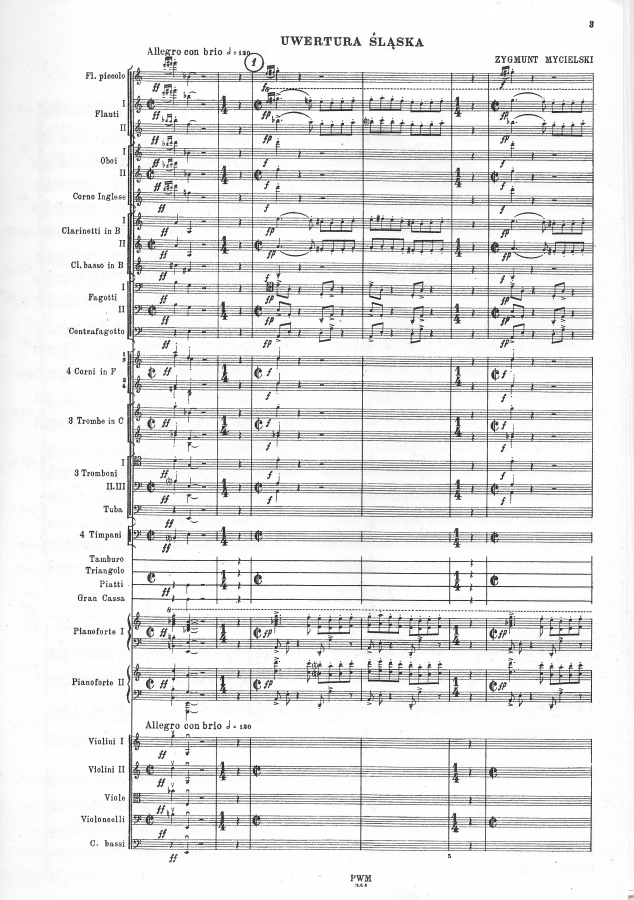
Silesian Overture for orchestra and two pianos (1948)
instrumentation: fl picc, 2 fl, 2 ob, cor ing, 2 cl B, cl b B, 2 fg, cfg, 4 cor, 3 tr, 3 trbn, tb, 4 tmp, tmb, trgl, ptti, gr c, 2 pfte, quintetto d’archi
dedication: to Konstanty Ildefons Gałczyński
duration: ca 10’
edition: PWM 1950
premiere: Katowice, 1 January 1949, Polish Radio Symphony Orchestra, cond. Witold Rowicki
In letters to his mother from that period we can read about the composer’s desire to complete, for the purpose of the Olympic entry: a symphony (8 October 1947), an Olympic scherzo entitled Bieg do mety [Running Towards the Finish Line] (22? October 1947), an Olympic story (9 December 1947), an Olympic allegro (13 December 1947) and an overture (?? February 1948). After the submission deadline had passed, he also suggested a Finale concertante (2 March 1948), additionally considering giving the planned composition a programmatic title (16 June 1948).
In the end, during the summer holidays of 1948, when Mycielski was taking a break from his organisational duties in Warsaw and Kraków, he composed the Overture – which had been planned for a year – while he was staying in Katowice, where he enjoyed Bolesław Woytowicz’s hospitality. When the composer was still adding the last performance-related remarks, the score already attracted the attention of Witold Rowicki, who premiered the work on 1 January 1949 with the Katowice-based Symphony Orchestra of the Polish Radio.
Mycielski’s Overture enjoyed considerable popularity – in the first few months of 1949 it was recorded on tape, new performances were scheduled in Poznań and Kraków, and Polskie Wydawnictwo Muzyczne included it in its publishing plans. It was also performed during the first concert of the Łagów Congress (alongside Zbigniew Turski’s Olympic Symphony and Kazimierz Sikorski’s Overture for Small Orchestra), after which the composer’s mother received words of praise and congratulations from many representatives of the music world: Bolesław Woytowicz (“I’m happy to see that Zygmunt’s overture achieved such great success and that I can report on it to you, Madam, although I’d always been certain that the piece was in for a never-ending journey across the world’s concert halls”), Tadeusz Szeligowski (“I’m very happy, because Zygmunt won! Among all colleagues, including stern musicologists and other learned men. I am so happy about that”), Kazimierz Sikorski (“I always said that Zygmunt would do well and it’s true, because he is a wise man and composer”), Jan Krenz (“I know, value and like Zygmunt as a man; after getting to know the Overture, I can say the same about him as a musician”) and Stanisław Wisłocki (“I’m very happy for Zygmunt because of his success in Łagów. Given his modesty, it’s good that his work has made a move for him”).
In the introduction to the Łagów performance of the Overture we read:
Initially, the composer intended to use the idea for the Overture to write a piece for the International Olympic Competition, but because he was unable to take part in the competition due to time constraints and the Overture was written much later in Katowice, the author called it Silesian.
In the opinions expressed after the Łagów performance and published in Ruch Muzyczny, judgements of musicians linking Mycielski’s composition to the traditional neoclassical language and style, and pointing to its French stylistic roots, were mixed with those of politicians seeing in the Overture a “contemporary[,] serious [...] work, which we generally appreciate in its idea”.
The musical language of Zygmunt Mycielski’s Silesian Overture draws very strongly on the style of Igor Stravinsky, condemned by the Soviet authorities, especially on the ballet Petrushka. The form of the work is that of a reprise (ABA1) with an allusion to the sonata form.
